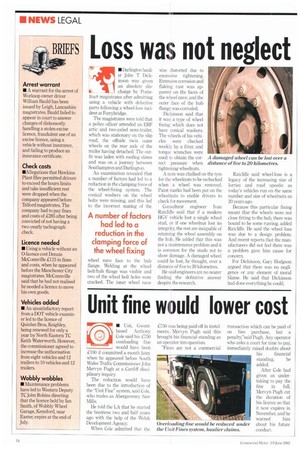Loss was not neglect
Page 16

If you've noticed an error in this article please click here to report it so we can fix it.
• Darlington haulier John T Dickinson was given an absolute dis
"C charge by Pontefract magistrates after admitting using a vehicle with defective parts following a wheel-loss incident at Ferrybridge.
The magistrates were told that a police officer attended an ERF attic and two-axled semi-trailer, which was stationary on the slip road, the offside twin outer wheels on the rear axle of the trailer having detached. The outfit was laden with roofing slates and was on a journey between Southampton and Darlington.
An examination revealed that a number of factors had led to a reduction in the clamping force of the wheel-fixing system. The conical washers on the wheel bolts were missing, and this led to the incorrect mating of the wheel nave face to the hub flange. Welding at the wheel bolt/hub flange was visible and two of the wheel bolt holes were cracked. The inner wheel Was distorted due to excessive tightening. Extensive corrosion and flaking rust was apparent on the faces of the wheel nave, and the outer face of the hub flange was corroded.
Dickinson said that it was a type of wheel fixing which does not have conical washers. The wheels of his vehicles were checked weekly by a fitter, and torque wrenches were used to obtain the correct pressure when tightening wheelnuts.
A note was chalked on the tyre for the wheelnuts to be rechecked when a wheel was removed. Paint marks had been put on the wheelnuts to enable drivers to check for movement.
Consultant engineer Ivan Ratcliffe said that if a modern HGV vehicle lost a single wheel stud, or if one wheelnut lost its integrity, the rest are incapable of retaining the wheel assembly on the hub. He added that this was not a maintenance problem and it is common for the studs not to show damage. A damaged wheel could be lost, he thought, over a distance of five to 20 kilometres.
He said engineers are no nearer finding the definitive answer despite the research. Ratcliffe said wheel-loss is a legacy of the increasing size of lorries and road speeds: as today's vehicles run on the same number and size of wheelnuts as 20 years ago.
Because this particular fixing meant that the wheels were not close fitting to the hub, there was bound to be some rusting, added Ratcliffe. He said the wheel loss was due to a design problem. And recent reports that the manufacturers did not feel there was a problem gave him cause for concern.
For Dickinson, Gary Hodgson argued that there was no negligence or any element of moral blame. He said that Dickinson had done everything he could.




















































































